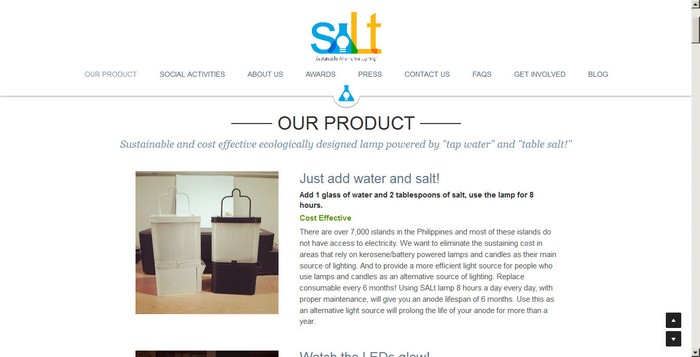Saltwater-Powered Lamp? Filipinos Will Be Commercializing One, the SALt Lamp
In the Philippines, using salt and cooking oil to produce fire for lighting is not uncommon. Many households still do this to deal with power outages, especially when kerosene is not available. These households may consider a safer alternative they can even take pride in as a Filipino brother and sister tandem successfully created a lamp that runs on saltwater.
The Inventors
The creators of this impressive lighting device are siblings Aisa and Raphael Mijeno. Aisa is an engineer and an Engineering faculty member at the Lipa campus of De La Salle University. A member of Greenpeace Philippines, she has reached several parts of the Philippines and has witnessed the need for efficient, safe, and cheap lighting solutions for people in the rural areas. Raphael Mijeno, on the other hand, is a BS Business Management graduate. Aisa Mijeno is mainly responsible for the invention but Raphael contributed some inputs.
Aisa Mijeno, in an interview with a news organizationi n the Philippines, said that she went through tedious experimentations to find chemical compounds, catalysts, and metal alloys that would produce the best levels of electricity when submerged in electrolytes. Aisa received several awards for the invention including the Kotra Award and People’s Choice Award at the Startup Nations Summit in 2014, Asia Entrepreneurship Award (2015), IdeaSpace Innovation for Impact (2015), and Echelon TOP100, NRF TechVenture Award (2015).
SALt Lamp
The saltwater powered lamp is called the SALt lamp. SALt stands for Sustainable Alternative Lighting, which is the name of the company put up by the siblings to pursue the mass production of the lamp and the development of saltwater-based power generation technology.
The lamp looks like two stacked cubes with the top cube lighting up and the lower cube housing the saltwater and other components responsible for electricity generation. Only slightly shorter than a small bottle of mineral water, it is a very portable lamp that does not require batteries. Just fill the bottom part with the prescribed saline solution or with seawater. The lamp can light for up to eight hours with a saline solution of one glass of water and two teaspoons of salt.
How It Works
The lamp operates using the principles behind the Galvanic cell, the foundation for battery making. However, instead of using toxic or hazardous electrolytes, the device uses the safe and abundant salt and water solution.
Since the lamp is meant to be sold partly as a commercial endeavor, the inventors are not keen on sharing the specific kind and dimensions of the metal alloys used in the lamp. The lamp can actually be created as a DIY project but certain metals with the right dimensions will be required for efficient power generation. The surface area of the metals used affects the voltage of the resulting electricity. Hence, it shouldn’t be too high so it won’t burn the LED and not too low to make the LED light at its most efficient level.
The idea of generating electricity from saltwater is not new. In 2011, Indian students Shyam Prasad and B. Srikanth of B. Tech (EIE) made news when they showed an experimental setup for generating electricity from saltwater. They also used the power generated to light up an LED. Also in the same year, Stanford University researchers developed a saltwater-based power generating device with one electrode that attracts positive sodium ions and another that attracts the negative ions of chlorine.
Advantages
Obviously, this lighting device comes with a multitude of advantages. For one, it does not require batteries or electricity. To recharge it, you just have to replace the electrolyte (saline solution). The device will not last forever as the metal rods will eventually degrade or corrode. They also have to be replaced. The inventors, however, say that the metal rods they used are expected to last for around two years.
Other advantages of this saltwater-powered lamp are its portability, usability in virtually all settings or weather conditions, ease of use, extremely cheap fuel (salt and water), and almost zero usage risks. Since it does not make use of toxic electrolytes, even if the saline solution within it is spilled, it is unlikely going to pose health hazards. The LEDs also provide the advantages of being long-lasting and shock-proof so you can expect the lamp to be durable. If it breaks, it shouldn’t be difficult repairing it. Moreover, the lamp is environment-friendly. It does not emit harmful gases. It does not make use of mercury and toxic substances for generating power and light. Most importantly, the fuel it uses is renewable and easy to source.
The lamp may also be used to recharge a mobile phone as it comes with a USB port (power only connection). You just have to be careful not to spill the saline solution onto your device.
Availability
There are no details on the commercial availability of the lamp yet. However, it will be made available to several beta testers across the Philippines. Several lamps will also be donated to households in rural areas in the provinces to help them enjoy the benefits of brighter and inexpensive lighting while testing the longevity and efficiency of the lamps. This is one of the highly useful inventions worth pursuing so hopefully it becomes ready for the mass market very soon.


